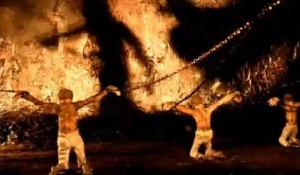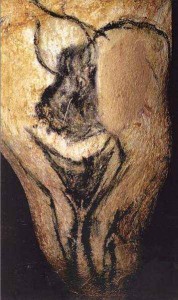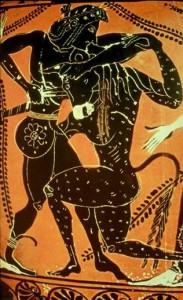Slaying the Minotaur — Herzog’s Cave of Forgotten Dreams (Part 2)
For shamanic religions and the cultures that adhere to them, mystery is higher than knowledge. The irrational higher than the rational. Unknowing higher than knowing. (Is there even a concept of “knowing”? Is “knowing” an idea that has only arisen in after writing??) Paleolithic people, such as those who left their mark in Chauvet Cave 32,000 years ago (see Werner Herzog’s amazing new documentary), undoubtedly believed, as modern shamans do, in ready passage to other worlds, and in the ability of humans to become animals (and vice versa). They accomplished these feats via drugs and drumming and dreams and, probably, via the sensory deprivation provided by caves.
Vestiges of such practices are found throughout the shamanic religions that have survived into our own times. And they were well active in Ancient Greece, the earliest European civilization of which we have much written record. The mystery cults of Dionysus and other deities probably represent vestiges of prehistoric religions. Caves were viewed as the sanctums of gods, and venturing into the dark was a rite and a means of access to the other world.
 But somewhere along the line, a profound shift happened in Europeans’ beliefs about the dark. We have long since stopped venturing into the dark for religious communion. Civilized humans have long since ceased to find little but fright, scientific curiosity, and for some, physical adventure in subterranean space. Plato, perhaps the first fully “modern” thinker, famously viewed the cave as a prison of ignorance, not a church. In his metaphor, the cave was a place were people were enchained, watching shadows of puppets projected by a light on a wall (an image uncannily similar to a movie theater—see previous post), and from which they had to be liberated and led out into the light…
But somewhere along the line, a profound shift happened in Europeans’ beliefs about the dark. We have long since stopped venturing into the dark for religious communion. Civilized humans have long since ceased to find little but fright, scientific curiosity, and for some, physical adventure in subterranean space. Plato, perhaps the first fully “modern” thinker, famously viewed the cave as a prison of ignorance, not a church. In his metaphor, the cave was a place were people were enchained, watching shadows of puppets projected by a light on a wall (an image uncannily similar to a movie theater—see previous post), and from which they had to be liberated and led out into the light…
Judeo-Christianity inherited the preference for light and reason over mystery. Consider the Medieval cathedral. It is dark, but it is dark the way a camera is dark: It is a space designed to let light in, via stained-glass windows whose secret formulas died with the alchemists of the period. A cathedral thus reveals the light in a new way. In Eastern religions, “enlightenment” happened via practices of meditation, similar to prayer, not via descent into caves.
Despite our tendency to view the organized religions familiar to us as “irrational” enemies of the scientific worldview, they were intended to enlighten, not obscure or distort reality. Thus they really go hand in hand with philosophy and science. Science could not have arisen in any other but the matrix of Christianity, Islam, and the other religions of enlightenment. (Modern scientific antagonists of religion would do well to bear this in mind.)
 In this regard—the changing meaning of and attitude toward the dark—I wonder if it is significant that the sole apparently “mythological” and (semi-)human representation found in Chauvet Cave is a being with the lower half of a “Venus” and the upper body of a bull—painted ingeniously on a stalactite. Where else in our cultural memory does a half-human, half-bull creature appear? Obviously, in the great Greek myth of the labyrinth of Crete, and the Minotaur inhabiting it. The labyrinth in this story is widely thought to have been a cave, or symbolic of the cave. Could the bull-man be an ancient—incredibly ancient—symbol of something like the “spirit” of caves, or of the dark, that survived into Greek times?
In this regard—the changing meaning of and attitude toward the dark—I wonder if it is significant that the sole apparently “mythological” and (semi-)human representation found in Chauvet Cave is a being with the lower half of a “Venus” and the upper body of a bull—painted ingeniously on a stalactite. Where else in our cultural memory does a half-human, half-bull creature appear? Obviously, in the great Greek myth of the labyrinth of Crete, and the Minotaur inhabiting it. The labyrinth in this story is widely thought to have been a cave, or symbolic of the cave. Could the bull-man be an ancient—incredibly ancient—symbol of something like the “spirit” of caves, or of the dark, that survived into Greek times?
Myths were never meant to be taken literally, and typically they weren’t. The ancients weren’t as credulous as we tend to think. Myths are stories that symbolically encode memories of great events and social, political, economic, and religious transitions—they are the form taken by oral history, the cultural memory of a people. For example, the legend of St. Patrick expelling all the snakes from Ireland symbolically encodes the memory of the banishing of Celtic pagan religion by the arrival of Christianity. (Snakes have always been symbolic of old superstitious cults. The serpent in Eden represented, for the Hebrews, the false, primitive, evil, sacrificial cults that surrounded them in the Levant.)
 I cannot help but wonder whether the story of Theseus slaying the Minotaur in the labyrinth of Crete could represent a cultural memory not unlike the story of St. Patrick: A symbolic encoding of the banishment of old mystery cults in favor of a newer, more Platonic view of the universe as something to be illuminated—the first inklings of a scientific worldview, the regime of logic and reason that even to this day is represented by Ariadne’s thread—a way out of the cave.
I cannot help but wonder whether the story of Theseus slaying the Minotaur in the labyrinth of Crete could represent a cultural memory not unlike the story of St. Patrick: A symbolic encoding of the banishment of old mystery cults in favor of a newer, more Platonic view of the universe as something to be illuminated—the first inklings of a scientific worldview, the regime of logic and reason that even to this day is represented by Ariadne’s thread—a way out of the cave.
I’d welcome any response to this idea from experts in Greek mythology: What is the significance of the bull, and the bull-man? Is the Minotaur a cthonic symbol of darkness and mystery, one that could have its roots in a dim Paleolithic past?
***




This cave is mythical and very mysterious from the looks of it. It gives me goosebumps.. EErrrrr…. Quite scary